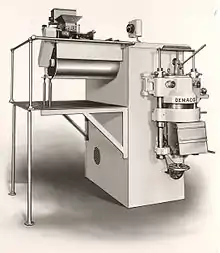Demaco extruder
The Demaco extruder is a pasta extruder built by Demaco in West Melbourne, Florida, United States. It is the first pasta extruder ever built for USDA sanitary food plants.[1] Its design allowed food producers to use an extruder directly in fresh, frozen and canning factories.

History
The Demaco extruder evolved from a mechanical pasta press first built in 1914. The mechanical press was replaced by the hydraulic press shortly afterwards.
The Demaco extruder with an auger screw and mixer combined the functions of mixing, kneading and extruding in one machine. Previously, these operations required three separate machines.
In the 1960s, the Demaco extruder underwent a series of changes that made the machine easy to sanitize and suitable for USDA food plants. These included a streamlined design with quick disassembly and stainless steel construction with completely sealed welds.[2] Demaco engineers also designed a premixer for the Demaco extruder, which received a U.S. patent in 1975.[3] In the 1980s, the Demaco extruder became automated with PLC controls.
Canned goods
An innovative use of the Demaco extruder was feeding a can-filling machine for canned products.[2] Demaco extruders also feed ravioli machines to make canned ravioli products.
Notes
- United States Department of Agriculture. FSIS Directive 11220.1 "Accepted Meat and Poultry Equipment", Food Safety and Inspection Service (Washington, DC: U.S. Government Printing Office, November 1995), p. 50-51.
- Judson M. Harper. Extrusion of Foods: Volume I (Boca Raton, Florida: CRC Press), p. 150.
- Ignatius Bontempi and Peter Giemisch. U.S. Patent 3,891,192 "Pre-Mixer for Alimentary Paste" (Washington, DC: USPTO, June 24, 1975).
| Wikimedia Commons has media related to Demaco extruders. |